Know the Etymology: 204
Place Name of the Day: Wednesday, 20 April 2011
Thalpitiya, Thaaligala, Thaazhaiyadi, Kaththaazhampiddi
தல்பிட்டிய, தாலிகல, தாழையடி
Talpiṭiya, Tālikala, Tāḻaiyaṭi, KattāḻampiṭṭiThal+pitiya
Thaali+gala
Thaazhai+adi
Kaththaazhai+piddi
The plain or high ground of palmyra palms
The rocky place of talipot palms
The locality of screw-pines
The high ground of aloe
| Tal |
Also Tal-gaha, Taala: The palmyra palm, Borassus flabelliformis (Sinhala); Tala, Tala-gaha, Taali, Taalee: The mountain palm, or Talipot, Corypha taliera (Sinhala); Hin-taala: Means, the small Taala; the jaggery plam or the Kitul palm, Caryota urens; the marshy date palm Phoenix paludosa (Sinhala); Tal-kola, Talapata, Taalapatra; Leaf of palmyra palm (Sinhala); Taala: The palmyra palm (Sanskrit); Taala, Taada: The palmyra palm (Prakrit/ Pali); Taala-panna: Palmura palm leaf used for writing (Pali); Taala-patta: A whole palm leaf used for thatching etc (Pali); Taazh: The palmyra palm (Kannada, DED 3180); Thaali: The palmyra palm (Tamil, Thivaakaram lexicon 4:73, Pingkalam 9:106, Choodaamani 4:10); the Talipot palm, Carypha umbraculifera (Tamil, MTL); the jaggery palm, also Koonthal-panai, Caryota urens (Tamil, Pingkalam Lexicon 9:108); Taari, Taali: The palmyra palm (Tulu, DED 3180); Taadu: also Taazhu ( Telugu inscriptions), Taati-cettu: the palmyra palm (Telugu, DED 3180); Taazh-related cognates, meaning the palmyra palm, are found in the Dravidian languages, Kolami, Naikri, Parji, Gadba, Gond, Konda, Pengo, Kuwi, Kurux and Malto (DED 3180); Taazhai: Fragrant screw-pine, coconut palm (Tamil, DED 3183); Taazhe: Fragrant screw-pine, Pandanus odoratissimus (Kannada, 3183); Taare, Taale: Coconut palm (Tulu, DED 3183); Taalip-panai: The talipot palm (Tamil, MTL); Kat-taazhai, Kath-thaazhai: (Kattai-thaazhai) The aloe that grows as a tuft (Tamil, Thivaakaram Lexicon 4:155; Kattai, Kaththai: tuft, bundle as of grass etc, Tamil DED 1400); Thaazh: (verb) To fall low, droop down (Tamil, DED 3178); (adjective) hanging, drooping, falling low (Tamil, DED 3178)
|
| Piddi |
High ground, mound, bank, plain, etc (Eezham Tamil); Pitiya: Means the same as Piddi in Eezham Tamil (Sinhala). See column on Kurumpachiddi.
|
| Gala |
Rock, stone (Singala); Rocky place, rocky hill (Sinhala place names); Kal: means the same as in Sinhala (Tamil, DED 1298). See column on Kurunegala
|
| Adi |
Locality, a place or spot (Tamil: either from Adi, meaning base, bottom; Tamil/ DED 72, or a derivative of A, meaning that place or that spot; Tamil/ DED 1)
|

Tal (Sinhala), Taala (Sanskrit/ Prakrit/ Pali), Taazh (Old Kannada), Thaali (Old Tamil, Tulu): the palmyra palm, Borassus flabelliformis. [Image courtesy: reference.findtarget.com]
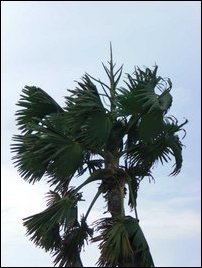
Tala, Taali, Taalee (Sinhala), Thaali, Thaalip-panai (Tamil), the Talipot palm or the mountain palm, Corypha taliera, Corypha umbraculifera, [Image courtesy: talipotmiami.com]
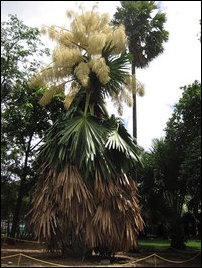
Tala, Taali, Taalee (Sinhala), Thaali, Thaalip-panai (Tamil), Corypha taliera, Corypha umbraculifera a young Talipot palm in blossom; note how a young talipot palm looks like when the old leaves are not cut and removed [Image courtesy: Cumulus Clouds, commons.wikimedia.org]
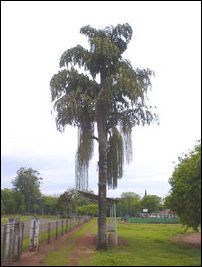
Thaali, Koonthal-panai (Tamil), Kithul, Hin-taala (Sinhala), the jaggery palm, Corypha urens of the Arecaceae family. Note the spathe resembling tresses of hair (Koonthal in Tamil). [Image courtesy: rc.unesp.br]
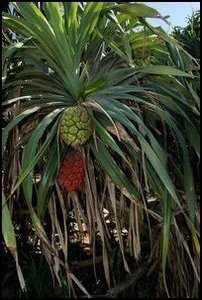
Thaazhai (Tamil), Moodu-keyiyaa (meaning the sea-fruit; Sinhala), the screw-pine tree, Pandanus odoratissimus, [Image courtesy: Dominique Schreckling, Pbase.com]
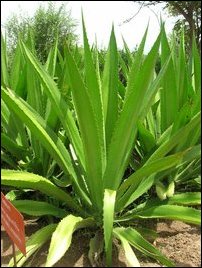
Kattaazhai, Kaththaazhai, Kumari (Tamil), Komaarikaa, Koamaarikaa (Sinhala), Aloe, Aloe vulgaris [Image courtesy: Tamil Nadu Agricultural University, agritech.tnau.ac.in]
Tal, Tal-gaha and Taala in Sinhala mean the palmyra palm, Borassus flabelliformis.
Another related species, the mountain palm or the Talipot palm, Corypha taliera or Corypha umbraculifera, peculiar to the Western Ghats of South India and to the wet zone of the island of Sri Lanka, is called in Sinhala as Tala, Tala-gaha, Taali and Taalee.
Hin-taala, literally meaning the small Taala, stands for both the Kitul palm or jaggery palm, Caryota urens as well as the marshy date palm, Phoenix paludosa in Sinhala.
The Sinhala names may look corresponding to Taala in Sanskit, Prakrit and Pali, meaning a palmyra palm. But a comparison of the terms with Dravidian diction for palm variety of trees would show that the terms are of Dravidian etymology.
Connected to the Tamil/ Dravidian verb root, Thaazh (DED 3178), meaning hanging, drooping or falling down, the derivatives Thaazhai, Thaali etc and their cognates in Dravidian languages seem to be a generic term for the palm variety of trees the leaves of which hang down.
The Thaazh-derived names and cognates in nearly 14 Dravidian languages mean the palmyra palm, talipot palm, jaggery palm, coconut palm and the screw-pine palm (Tami lexicons, Dravidian Etymological Dictionary 3180, 3183).
Note that Taazh means palmyra and Taazhe means the screw-pine palm in Kannada, while in Tamil, Thaazhai is screw-pine as well as coconut palm (literary), and Thaali is palmyra, talipot and jaggery palms. Thaalip-panai is a specific term for the talipot and Thaali-panai as well as Koonthal-panai (Kithul in Sinhala) means the jaggery palm in Tamil. Also note the cognates with ZH/ L/ D/ R interchange in the other Dravidian languages, referred to in the table above.
A related plant aloe that grows as a tuft is called in Tamil as Kat-taazhai or Kath-thaazhai (Kattai-thaazhai, Kaththai-thaazhai). Kattai or Kaththai in Tamil means a tuft or bundle as of grass etc (Tamil, DED 1400)
While the Dravidian generic term under discussion is exclusively used for the screw-pine in contemporary Tamil, the cognate of the term is used for the palmyra and the talipot palm in Sinhala and in the other languages.
In this context, note that another Dravidian generic term Pul, meaning grass family of plants including the palms in old Tamil, means only grass in contemporary Tamil and its cognate Pol means the coconut palm in Sinhala. (See column on
Polgolla)
* * *Thaazh, meaning falling down: வரையின் தாழ்ந்த வால் வெள் அருவி (குறுந்தொகை 284: 6)
Varaiyin thaazhntha vaal vel aruvi (the milky white waterfall of the stream, falling down from the hill; Kurunthokai 284: 6)
தாழ்ந்த நல் நெடுங் கூந்தல் (நற்றிணை 10: 2-3)
Thaazhntha nal nedung koonthal (The good, long hair falling down low; Nattinai 10: 2-3)
Thaazh, referring to drooping leaves of the palmyra palm:மடல் தாழ் பெண்ணை எம் சிறு நல் ஊரே (குறுந்தொகை 81: 4-7)
Madal thaazh pennai em chiru nal oorea (Our small, good, village having palmyra palms of drooping fronds; Kurunthokai 81: 4-7)
Thaazhai meaning the fragrant screw-pine: கானல் அம் பெருந்துறை வெள் வீத் தாழை (குறுந்தொகை 163: 3-4)
Kaanal am perunthurai vel veeth thaazhai (the screw-pine of white flowers in the marsh grove of the great seashore; Kurunthokai 163: 3-4)
Thaazhai, meaning the coconut palm:குலை இறைஞ்சிய கோட் தாழை (புறநானூறு 17:9)
Kulai iraignchiya koad thaazhai (the coconut palm of the attribute of having drooping bunches of fruits; Puranaanooru 17:9)
Thaali, meaning the palmyra palm: பெண்ணை, தாலம், புல், தாளி
பனை என இசைப்பர் (திவாகரம் 4:73)
Pennai, thaalam, pul, thaali
panai ena isaippar (Pennai, Thaalam, Pul, Thaali etc are the synonyms of Panai, i.e the palmyra palm; Thivaakaram Lexicon 4: 73, c. 8th century CE, 4:73)
Thaali meaning the jaggery palm called Kithul in Sinhala தாளிப் போந்தின் தரு மயிர்ப் பெருந்தலை (கல்லாடம் 33: 3)
Thaalip poanthin tharu mayirp perunthalai (The big head of hanging tresses of hair, resembling the spathe or the hanging bunch of the jaggery palm; Kallaadam 33: 3). Thaali in this meaning, also has a synonym Koonthal-panai in Tamil as the spathe of the jaggery palm resembles the long hair of women:
தாளி, கூந்தல், பனை (பிங்கலம் 9:108)
Thaali, koonthal, panai (Thaali means Koonthal Panai; Pingkalam Lexicon, 9:108)
Thaalip-panai meaning the talipot palm noted for its leaves: தாளிப் பனையின் இலை போல மயிர்க் கட்டு (காரைக்கால் அம்மையார், திருவாலங்காட்டு மூத்த திருப்பதிகம், 6)
Thaalip panaiyin ilai poala mayirk kaddu (the hair looking like the leaves of the talipot palm, the comparison here is made for the hair of devils; Kaaraikkaal Ammaiyaar, Thiruvaalangkaaddu Mooththa Thiruppathikam: 6, c. 5-6th century CE)
Kattaazhai, meaning aloe: குமரி கற்றாழை ஆகக் கூறுவர் (திவாகரம் 4: 155)
Kumari kattaazhai aakak kooruvar (Kumai and Kattaazhai are synonyms; Thivaakaram Lexicon 4: 155)
* * *Thal-pitiya is in Panadura division of Kalutara district.
Thaali-gala is in Ambantota division of Hambantota district.
Thaazhaiyadi is in Vadamaraadchi East division of Jaffna district. There is another Thaazhaiyadi in Karaithuraippattu division of Mullaiththeevu district.
Kaththaazhampiddi is in Maanthai West division of Mannaar district.
* * *
Some related place names:Thalapath-pitiya: The high ground of talipot palms to collect leaves; Maharagama division, Colombo district
Thal-gas-mote: The natural pond of palmyra palms; Attanagala division, Gampaha district. Mote is the Sinhalicized form of Moaddai meaning a natural pond in Eezham Tamil. (See column on
Kadaiya-moaddai)
Thal-gas watta: The grove of palmyra palms; Dompe division Gampaha district
Thalawathu-hen-pita: The high ground of slash and burn garden field of talipot palms; Kelaniya division, Gampaha district
Thal-watta: The grove of palmyra palms; Biyagama division, Gampaha district; KFG and G division, Kandy district; Katuwana division, Hambantota district
Thal-pitiya: The high ground of palmyra palms; Panadura division, Kalutara district
Thalathu-oya: The stream of talipot palms; Patha-hewaheta division, Kandy district
Thal-kote: The enclosure of palmyra palms; Dambulla division, Matale district
Thal-gaha-goda: The bank or hill of palmyra/ talipot palms; Yatawatta division, Matale district
Thal-gas-yaaya: The expanse of palmyra palms; Matale division, Matale district; Akmeemana division, Galle district
Thala-gas-pe: The jungle or grove of palmyra/ talipot palms; Elpitiya division, Galle district
Thalan-galla: The rocky hill or rocky place of palmyra palms; Thawalama division, Galle district
Thal-gas-wala: The jungle of palmyra palms; Nagoda division, Galle district
Thal-gas-goda: The bank or hill of palmyra palms; Ambalangoda division, Galle district
Thala-pitiya: The high ground of palmyra/ talipot palms; Galle Four Gravets division, Galle district
Thal-pe: The jungle or grove of palmyra palms; Akmeemana division, Galle district; Habaraduwa division, Galle district
Thal-doova: The water surrounded area of palmyra palms; Habaraduwa division, Galle district; Dehiovita division, Kegalle district
Thal-gampala: Yakkalamulla division, Galle district
Thali-gala: The rocky hill of talipot palms; Ambalantota division, Hambantota district
Thalpath-kanda: The hill of talipot palms; Katuwana division, Hambantota district
Thala-pe-kumbura: The paddy field of palmyra/ talipot palms; Pitabeddara division, Matara district
Thal-aramba: Weligama division, Matara district
Thalpavila: The pond of palmyra palms; Matara Four Gravets division, Matara district
Thal-alla: The stream of Palmyra palms; Devinuwara division, Galle district
Thala-kola-wewa: The tank of palmyra palms to get leaves; Polpithigama division, Kurunegala district; Anamaduwa division, Puththalam district; Medirigiriya division, Polonnaruwa district
Thalpat-wewa: The tank of palmyra/ talipot palms to get leaves; Polpithigama division, Kurunegala district
Thal-wehera: The Buddhist temple of palmyra/ talipot palms; Polpithigama division, Kurunegala district
Thal-vita: The mound or hill of palmyra/ talipot palms; Kurunegala division, Kurunegala district
Thal-gaha-wewa: The tank of palmyra palms; Rambewa division, Anuradhapura district
Thal-gas-wewa: The tank of palmyra palms; Nochchiyagama division, Anuradhapura district
Thala-gaha-gedara: The house premises of talipot palms; Passara division, Badulla district
Thala-kumbura: The paddy field of talipot palms; Kandaketiya division, Badulla district
Thal-gamuwa: The village of talipot/ palmyra palms; Aranayake division, Kegalle district
Thal-gas-pitiya: The high ground of talipot/ palmyra palms; Aranayake division, Kegalle district
Thal-gaha-deniya: The land of talipot/ palmyra palms; Warakapola division, Kegalle district
Thala-vitiya: The hill of talipot palms; Kuruvita division, Ratnapura district
Thala-gas-kanda: The hill of talipot palms; Weligepola division, Ratnapura district
Thaazhai:Thaazhaiyadi: The locality of screw pines; Vadamaraadchi East division, Jaffna district; Karaithuraippattu division, Mullaiththeevu district
Chinnath-thaazhaiyadi: The smaller village of the name Thaazhaiyadi (the locality of screw pines); Pachchilaipppalli division, Kilinochchi district. The name differentiates it from Thaazhaiyadi, the bigger village nearby.
Thaazhang-kudaa: The corner of the lagoon having screw pines; Aaraippattai division, Batticaloa district
Peaththaalai: Peayth-thaazhai: (the place of) a variety of screw pines; Vaazhaichcheanai division, Batticaloa district
Kattaazhai, Kaththaazhai:Kaththaazham-piddi: The high ground of aloe; Maanthai West division, Mannaar district
First published: Wednesday, 20 April 2011, 23:54
Previous columns:












